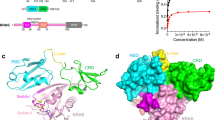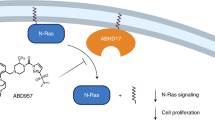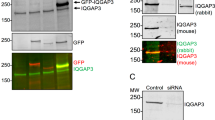Abstract
The localization of prenylated Ras at the plasma membrane promotes activation of Ras by receptor tyrosine kinases and stimulates oncogenic signaling by mutant Ras. The Nogo-B receptor (NgBR) is a transmembrane receptor that contains a conserved hydrophobic pocket. Here, we demonstrate that the NgBR promotes the membrane accumulation of Ras by directly binding prenylated Ras at the plasma membrane. We show that NgBR knockdown diminishes the membrane localization of Ras in multiple cell types. NgBR overexpression in NIH-3T3 fibroblasts increases membrane-associated Ras, induces the transformed phenotype in vitro, and promotes the formation of fibrosarcoma in nude mice. NgBR knockdown in human breast cancer cells reduces Ras membrane localization, inhibits epidermal growth factor (EGF)-stimulated Ras signaling and diminishes tumorigenesis of xenografts in nude mice. Our data demonstrate that NgBR is a unique receptor that promotes accumulation of prenylated Ras at the plasma membrane and promotes EGF pathways.
This is a preview of subscription content, access via your institution
Access options
Subscribe to this journal
Receive 50 print issues and online access
$259.00 per year
only $5.18 per issue
Buy this article
- Purchase on Springer Link
- Instant access to full article PDF
Prices may be subject to local taxes which are calculated during checkout







Similar content being viewed by others
References
Ahearn IM, Haigis K, Bar-Sagi D, Philips MR . Regulating the regulator: post-translational modification of RAS. Nat Rev Mol Cell Biol 2012; 13: 39–51.
Karnoub AE, Weinberg RA . Ras oncogenes: split personalities. Nat Rev Mol Cell Biol 2008; 9: 517–531.
Konstantinopoulos PA, Karamouzis MV, Papavassiliou AG . Post-translational modifications and regulation of the RAS superfamily of GTPases as anticancer targets. Nat Rev Drug Discov 2007; 6: 541–555.
Cox AD, Der CJ, Philips MR . Targeting RAS membrane association: back to the future for Anti-RAS drug discovery? Clin Cancer Res 2015; 21: 1819–1827.
Schmick M, Kraemer A, Bastiaens PI . Ras moves to stay in place. Trends Cell Biol 2015; 25: 190–197.
Belanis L, Plowman SJ, Rotblat B, Hancock JF, Kloog Y . Galectin-1 is a novel structural component and a major regulator of h-ras nanoclusters. Mol Biol Cell 2008; 19: 1404–1414.
Rotblat B, Belanis L, Liang H, Haklai R, Elad-Zefadia G, Hancock JF et al. H-Ras nanocluster stability regulates the magnitude of MAPK signal output. PloS One 2010; 5: e11991.
Shalom-Feuerstein R, Plowman SJ, Rotblat B, Ariotti N, Tian T, Hancock JF et al. K-ras nanoclustering is subverted by overexpression of the scaffold protein galectin-3. Cancer Res 2008; 68: 6608–6616.
Chandra A, Grecco HE, Pisupati V, Perera D, Cassidy L, Skoulidis F et al. The GDI-like solubilizing factor PDEdelta sustains the spatial organization and signalling of Ras family proteins. Nat Cell Biol 2012; 14: 148–158.
Hanzal-Bayer M, Renault L, Roversi P, Wittinghofer A, Hillig RC . The complex of Arl2-GTP and PDE delta: from structure to function. EMBO J 2002; 21: 2095–2106.
Nancy V, Callebaut I, El Marjou A, de Gunzburg J . The delta subunit of retinal rod cGMP phosphodiesterase regulates the membrane association of Ras and Rap GTPases. J Biol Chem 2002; 277: 15076–15084.
Omerovic J, Laude AJ, Prior IA . Ras proteins: paradigms for compartmentalised and isoform-specific signalling. Cell Mol Life Sci 2007; 64: 2575–2589.
Prior IA, Harding A, Yan J, Sluimer J, Parton RG, Hancock JF . GTP-dependent segregation of H-ras from lipid rafts is required for biological activity. Nat Cell Biol 2001; 3: 368–375.
Rocks O, Peyker A, Bastiaens PI . Spatio-temporal segregation of Ras signals: one ship, three anchors, many harbors. Curr Opin Cell Biol 2006; 18: 351–357.
Rotblat B, Prior IA, Muncke C, Parton RG, Kloog Y, Henis YI et al. Three separable domains regulate GTP-dependent association of H-ras with the plasma membrane. Mol Cell Biol 2004; 24: 6799–6810.
Roy S, Luetterforst R, Harding A, Apolloni A, Etheridge M, Stang E et al. Dominant-negative caveolin inhibits H-Ras function by disrupting cholesterol-rich plasma membrane domains. Nat Cell Biol 1999; 1: 98–105.
Miao RQ, Gao Y, Harrison KD, Prendergast J, Acevedo LM, Yu J et al. Identification of a receptor necessary for Nogo-B stimulated chemotaxis and morphogenesis of endothelial cells. Proc Natl Acad Sci USA 2006; 103: 10997–11002.
Park EJ, Grabinska KA, Guan Z, Sessa WC . NgBR is essential for endothelial cell glycosylation and vascular development. EMBO Rep 2016; 17: 167–177.
Rana U, Liu Z, Kumar SN, Zhao B, Hu W, Bordas M et al. Nogo-B receptor deficiency causes cerebral vasculature defects during embryonic development in mice. Dev Biol 2016; 410: 190–201.
Zhao B, Chun C, Liu Z, Horswill MA, Pramanik K, Wilkinson GA et al. Nogo-B receptor is essential for angiogenesis in zebrafish via Akt pathway. Blood 116: 5423–5433.
Wang B, Zhao B, North P, Kong A, Huang J, Miao QR . Expression of NgBR is highly associated with estrogen receptor alpha and survivin in breast cancer. PloS One 2013; 8: e78083.
Zhao B, Xu B, Hu W, Song C, Wang F, Liu Z et al. Comprehensive proteome quantification reveals NgBR as a new regulator for epithelial-mesenchymal transition of breast tumor cells. J Proteomics 2014; 112C: 38–52.
Dong C, Zhao B, Long F, Liu Y, Liu Z, Li S et al. Nogo-B receptor promotes the chemoresistance of human hepatocellular carcinoma via the ubiquitination of p53 protein. Oncotarget 2016; 7: 8850–8865.
Liang PH, Ko TP, Wang AH . Structure, mechanism and function of prenyltransferases. Eur J Biochem 2002; 269: 3339–3354.
Abramovitz A, Gutman M, Nachliel E . Structural coupling between the Rho-insert domain of Cdc42 and the geranylgeranyl binding site of RhoGDI. Biochemistry 2012; 51: 715–723.
Hoffman GR, Cerione RA . Flipping the switch: the structural basis for signaling through the CRIB motif. Cell 2000; 102: 403–406.
Taylor SJ, Resnick RJ, Shalloway D . Nonradioactive determination of Ras-GTP levels using activated ras interaction assay. Methods Enzymol 2001; 333: 333–342.
Omerovic J, Prior IA . Compartmentalized signalling: Ras proteins and signalling nanoclusters. FEBS J 2009; 276: 1817–1825.
Prior IA, Hancock JF . Ras trafficking, localization and compartmentalized signalling. Semin Cell Dev Biol 2012; 23: 145–153.
Chang SY, Ko TP, Chen AP, Wang AH, Liang PH . Substrate binding mode and reaction mechanism of undecaprenyl pyrophosphate synthase deduced from crystallographic studies. Protein Sci 2004; 13: 971–978.
Chen AP, Chang SY, Lin YC, Sun YS, Chen CT, Wang AH et al. Substrate and product specificities of cis-type undecaprenyl pyrophosphate synthase. Biochem J 2005; 386: 169–176.
Guo RT, Ko TP, Chen AP, Kuo CJ, Wang AH, Liang PH . Crystal structures of undecaprenyl pyrophosphate synthase in complex with magnesium, isopentenyl pyrophosphate, and farnesyl thiopyrophosphate: roles of the metal ion and conserved residues in catalysis. J Biol Chem 2005; 280: 20762–20774.
Parish CA, Brazil DP, Rando RR . On the mechanism of the inhibition of transducin function by farnesylcysteine analogs. Biochemistry 1997; 36: 2686–2693.
Pechlivanis M, Kuhlmann J . Hydrophobic modifications of Ras proteins by isoprenoid groups and fatty acids—More than just membrane anchoring. Biochim Biophys Acta 2006; 1764: 1914–1931.
Williams CL . The polybasic region of Ras and Rho family small GTPases: a regulator of protein interactions and membrane association and a site of nuclear localization signal sequences. Cell Signal 2003; 15: 1071–1080.
Zohn IM, Campbell SL, Khosravi-Far R, Rossman KL, Der CJ . Rho family proteins and Ras transformation: the RHOad less traveled gets congested. Oncogene 1998; 17: 1415–1438.
Rocks O, Peyker A, Kahms M, Verveer PJ, Koerner C, Lumbierres M et al. An acylation cycle regulates localization and activity of palmitoylated Ras isoforms. Science 2005; 307: 1746–1752.
Roy S, Plowman S, Rotblat B, Prior IA, Muncke C, Grainger S et al. Individual palmitoyl residues serve distinct roles in H-ras trafficking, microlocalization, and signaling. Mol Cell Biol 2005; 25: 6722–6733.
Buday L, Downward J . Many faces of Ras activation. Biochim Biophys Acta 2008; 1786: 178–187.
McCubrey JA, Steelman LS, Abrams SL, Lee JT, Chang F, Bertrand FE et al. Roles of the RAF/MEK/ERK and PI3K/PTEN/AKT pathways in malignant transformation and drug resistance. Adv Enzyme Regul 2006; 46: 249–279.
McCubrey JA, Steelman LS, Chappell WH, Abrams SL, Wong EW, Chang F et al. Roles of the Raf/MEK/ERK pathway in cell growth, malignant transformation and drug resistance. Biochim Biophys Acta 2007; 1773: 1263–1284.
DeFeo D, Gonda MA, Young HA, Chang EH, Lowy DR, Scolnick EM et al. Analysis of two divergent rat genomic clones homologous to the transforming gene of Harvey murine sarcoma virus. Proc Natl Acad Sci USA 1981; 78: 3328–3332.
Land H, Parada LF, Weinberg RA . Tumorigenic conversion of primary embryo fibroblasts requires at least two cooperating oncogenes. Nature 1983; 304: 596–602.
Newbold RF, Overell RW . Fibroblast immortality is a prerequisite for transformation by EJ c-Ha-ras oncogene. Nature 1983; 304: 648–651.
Lacroix M, Leclercq G . Relevance of breast cancer cell lines as models for breast tumours: an update. Breast Cancer Res Treat 2004; 83: 249–289.
Hollestelle A, Elstrodt F, Nagel JH, Kallemeijn WW, Schutte M . Phosphatidylinositol-3-OH kinase or RAS pathway mutations in human breast cancer cell lines. Mol Cancer Res 2007; 5: 195–201.
Ikediobi ON, Davies H, Bignell G, Edkins S, Stevens C, O'Meara S et al. Mutation analysis of 24 known cancer genes in the NCI-60 cell line set. Mol Cancer Ther 2006; 5: 2606–2612.
Bernhard EJ, McKenna WG, Hamilton AD, Sebti SM, Qian Y, Wu JM et al. Inhibiting Ras prenylation increases the radiosensitivity of human tumor cell lines with activating mutations of ras oncogenes. Cancer Res 1998; 58: 1754–1761.
Sylvester PW . Optimization of the tetrazolium dye (MTT) colorimetric assay for cellular growth and viability. Methods Mol Biol 2011; 716: 157–168.
Kelly KJ, Sandoval RM, Dunn KW, Molitoris BA, Dagher PC . A novel method to determine specificity and sensitivity of the TUNEL reaction in the quantitation of apoptosis. Am J Physiol Cell Physiol 2003; 284: C1309–C1318.
Liang CC, Park AY, Guan JL . In vitro scratch assay: a convenient and inexpensive method for analysis of cell migration in vitro. Nat Protoc 2007; 2: 329–333.
Silva JM, Li MZ, Chang K, Ge W, Golding MC, Rickles RJ et al. Second-generation shRNA libraries covering the mouse and human genomes. Nat Genet 2005; 37: 1281–1288.
Hancock JF . Ras proteins: different signals from different locations. Nature Rev Mol Cell Biol 2003; 4: 373–384.
Walsh AB, Bar-Sagi D . Differential activation of the Rac pathway by Ha-Ras and K-Ras. J Biol Chem 2001; 276: 15609–15615.
Yan J, Roy S, Apolloni A, Lane A, Hancock JF . Ras isoforms vary in their ability to activate Raf-1 and phosphoinositide 3-kinase. J Biol Chem 1998; 273: 24052–24056.
Wright LP, Philips MR . Thematic review series: lipid posttranslational modifications. CAAX modification and membrane targeting of Ras. J Lipid Res 2006; 47: 883–891.
Brunsveld L, Waldmann H, Huster D . Membrane binding of lipidated Ras peptides and proteins - the structural point of view. Biochim Bipophys Acta 2009; 1788: 273–288.
Weise K, Huster D, Kapoor S, Triola G, Waldmann H, Winter R . Gibbs energy determinants of lipoprotein insertion into lipid membranes: the case study of Ras proteins. Faraday Discuss 2013; 161: 549–561.
Harrison KD, Park EJ, Gao N, Kuo A, Rush JS, Waechter CJ et al. Nogo-B receptor is necessary for cellular dolichol biosynthesis and protein N-glycosylation. EMBO J 2011; 30: 2490–2500.
Park EJ, Grabinska KA, Guan Z, Stranecky V, Hartmannova H, Hodanova K et al. Mutation of Nogo-B receptor, a subunit of cis-prenyltransferase, causes a congenital disorder of glycosylation. Cell Metab 2014; 20: 448–457.
Prior IA, Lewis PD, Mattos C . A comprehensive survey of Ras mutations in cancer. Cancer Res 2012; 72: 2457–2467.
Malaney S, Daly RJ . The ras signaling pathway in mammary tumorigenesis and metastasis. J Mammary Gland Biol Neoplasia 2001; 6: 101–113.
Clark R, Stampfer MR, Milley R, O'Rourke E, Walen KH, Kriegler M et al. Transformation of human mammary epithelial cells by oncogenic retroviruses. Cancer Res 1988; 48: 4689–4694.
Gunzburg WH, Salmons B, Schlaeffli A, Moritz-Legrand S, Jones W, Sarkar NH et al. Expression of the oncogenes mil and ras abolishes the in vivo differentiation of mammary epithelial cells. Carcinogenesis 1988; 9: 1849–1856.
Redmond SM, Reichmann E, Muller RG, Friis RR, Groner B, Hynes NE . The transformation of primary and established mouse mammary epithelial cells by p21-ras is concentration dependent. Oncogene 1988; 2: 259–265.
Dati C, Muraca R, Tazartes O, Antoniotti S, Perroteau I, Giai M et al. c-erbB-2 and ras expression levels in breast cancer are correlated and show a co-operative association with unfavorable clinical outcome. Int J Cancer 1991; 47: 833–838.
Miyakis S, Sourvinos G, Spandidos DA . Differential expression and mutation of the ras family genes in human breast cancer. Biochem Biophys Res Commun 1998; 251: 609–612.
Watson DM, Elton RA, Jack WJ, Dixon JM, Chetty U, Miller WR . The H-ras oncogene product p21 and prognosis in human breast cancer. Breast Cancer Res Treat 1991; 17: 161–169.
Nyati MK, Morgan MA, Feng FY, Lawrence TS . Integration of EGFR inhibitors with radiochemotherapy. Nat Rev 2006; 6: 876–885.
Toulany M, Kasten-Pisula U, Brammer I, Wang S, Chen J, Dittmann K et al. Blockage of epidermal growth factor receptor-phosphatidylinositol 3-kinase-AKT signaling increases radiosensitivity of K-RAS mutated human tumor cells in vitro by affecting DNA repair. Clin Cancer Res 2006; 12: 4119–4126.
Scaltriti M, Baselga J . The epidermal growth factor receptor pathway: a model for targeted therapy. Clin Cancer Res 2006; 12: 5268–5272.
Acknowledgements
Dr John Hancock at University of Texas Health Science Center at Houston generously provided pEGFP-C1 vector. This work is supported in part by start-up funds from Division of Pediatric Surgery and Division of Pediatric Pathology, Medical College of Wisconsin (MCW) and Advancing a Healthier Wisconsin endowment to MCW, AHA SDG 0730079N, NIH R01HL108938, Wisconsin Breast Cancer Showhouse (WBCS), Institutional Research Grant # 86-004-26 from the American Cancer Society, We Care Fund, Kathy Duffey Fogarty Award for breast cancer research, State of Wisconsin Tax Check-off program for breast & prostate cancer research and Children’s Hospital of Wisconsin Research Institute Pilot Innovative Research Grant to QRM., AHA postdoctoral fellowship 13POST13940002 and 11POST5690035, China State Key Basic Research Program Grant 2016YFA0501401 and the support from the Hundred Talents Program of CAS to BZ. Additional support was provided by NIH R01 CA188871 (CLW), the Rock River Cancer Research Foundation (CLW), and the Nancy Laning Sobczak, PhD., Breast Cancer Research Award (CLW), NIH R01HL128647 (ZY).
Author contributions
BZ, WH, SK, PG, UR, ZL, BW, WQD, QRM conducted the experiments; QRM, BZ, WH designed the experiments and wrote the paper; ZY provided computer modeling; CW provided reagents and edited the paper; QRM was responsible for overall integration and execution of the scientific approaches.
Author information
Authors and Affiliations
Corresponding author
Ethics declarations
Competing interests
The authors declare no conflict of interest.
Additional information
Supplementary Information accompanies this paper on the Oncogene website
Supplementary information
Rights and permissions
About this article
Cite this article
Zhao, B., Hu, W., Kumar, S. et al. The Nogo-B receptor promotes Ras plasma membrane localization and activation. Oncogene 36, 3406–3416 (2017). https://doi.org/10.1038/onc.2016.484
Received:
Revised:
Accepted:
Published:
Issue Date:
DOI: https://doi.org/10.1038/onc.2016.484
This article is cited by
-
GOLGA7 is essential for NRAS trafficking from the Golgi to the plasma membrane but not for its palmitoylation
Cell Communication and Signaling (2024)
-
Nogo-B receptor increases glycolysis and the paclitaxel resistance of estrogen receptor-positive breast cancer via the HIF-1α-dependent pathway
Cancer Gene Therapy (2023)
-
Association between high serum Nogo-B and hypertension in Chinese Han
BMC Cardiovascular Disorders (2022)
-
Nogo-B receptor increases the resistance to tamoxifen in estrogen receptor-positive breast cancer cells
Breast Cancer Research (2018)



